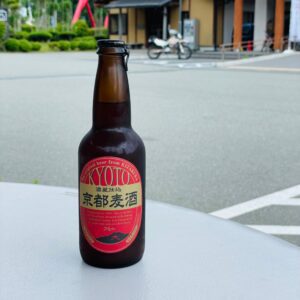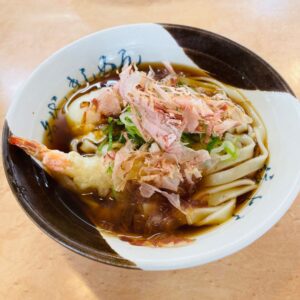June itinerary in Japan Day 3 (Kyoto, Aichi Meal edition)
(Friday, June 10)
Table of contents
4. Sumiyoshi, Kabuto, Izakaya Tsuruhachi
1. Restaurant Kitamura
I had a late breakfast before my stroll at “Miyama’s Thatched Village (Kayabuki no sato)”. I ordered “mori soba” (Yen 840), “rice with raw egg” (Yen 320), “dish simmered in regional chicken liver” (Yen 430), and “dish simmered venison with ginger” (Yen 430) at “Restaurant Kitamura“.
“Mori soba” is most popular buckwheat noodle at “Restaurant Kitamura”. It is made from buckwheat flour harvested in Miyama and ground on a millstone. The soba noodles are handmade in the restaurant every day. Despite being handmade soba, the noodles were very thin and made me feel that they were well worked. The amount of Soba was a little small, but it was a very tasty “mori soba”.

The “rice with raw egg” was made with freshly caught local eggs, and the rich yolk of the egg was delicious and irresistible.


The chicken and venison used in the “dish simmered in regional chicken liver” and “dish simmered venison with ginger” were also caught in Miyama. The meat is locally produced, full of flavor, and very tasty. It was a wonderful experience to eat breakfast using locally grown ingredients while breathing fresh air on the terrace overlooking the Miyama River (Yura River) that runs next to “Restaurant Kitamura”. It was a very enriching experience.

2. Cafe Milan
After enjoying a walk around “Miyama’s Thatched Village (Kayabuki no sato)”, I went to “Cafe Milan” to eat pudding. Cafe Milan is both an egg market and a café at Nakano Chicken Farm in “Miyama’s Thatched Village (Kayabuki no sato)”. It is located near the Miyama Folk Museum. Nakano Chicken Farm is located near “Restaurant Kitamura.

The pudding is handmade with rich eggs and raw farm milk as ingredients. The pudding looks like an egg from the top and is visually delicious as well. The pudding was so delicious that I ate it on the terrace while enjoying the view of “Miyama’s Thatched Village (Kayabuki no sato)”.

3. Takeyoshi
After a full day of exploring “Miyama’s Thatched Village (Kayabuki no sato)”, I cycled back to the Kyoto Tamba Kogen Quasi-National Park Visitor Center, about 20 minutes away, and had sweetfish cuisine at “Takeyoshi”.
The Miyama River (Yura River) is famous for its delicious sweetfish. The Miyama River grows high-quality diatoms that the sweetfish feeds on, which makes the sweetfish tasty. Sweetfish from the Miyama River has repeatedly won the runner-up prize (in 2008, 2013, 2014, 2015, and 2019) in the “Seiryu Meguri Sweetfish eating tournament,” an event where sweetfish from various regions of Japan are compared for taste, appearance, aroma, and other criteria to determine the grand prize winner. As such, it is known throughout the country for taste.
In 2022, the ban on tomozuri fishing (angling by decoy) for sweetfish was lifted on May 28. The ban on net fishing for sweetfish is scheduled to be lifted on August 21.
“Takeyoshi” offers sweetfish dishes without reservations. Note that there are only five restaurants in Miyama where we can eat sweetfish without a reservation. I had “Takeyoshi” for “grilled sweetfish with salt” (Yen 1,200), “whole sweetfish sushi” (Yen 1,200) and “Uruka” (Yen 200).
“Grilled sweetfish with salt” is the most famous way to eat sweetfish. When I visited Miyama on June 10, it was just after the opening of the sweetfish fishing season (May 28), so the sweetfish was still small. Even so, it was a very tasty “grilled sweetfish with salt” with no smell at all. Incidentally, the grilled sweetfish I had at Yorifuji in Yatsushiro City, Kumamoto Prefecture, in May was the best sweetfish I have ever tasted. I still cannot forget the sweetfish at Yorifuji.

As far as I can remember, I think this is the first time I ate “whole sweetfish sushi”. We can eat “whole sweetfish sushi” with the head of the sweetfish. Therefore, small sweetfish caught just after the opening of the sweetfish fishing season are more delicious and the head is more tender. The sweetfish sushi I had was also very tasty. I was glad to be able to try a new way of eating sweetfish other than “grilled sweetfish with salt”.


“Uruka” is salted sweetfish guts (internal organs). Takeyoshi’s Uruka was served on a bed of tofu. Sweetfish is one of the few fish that can eat its guts. This is because sweetfish feeds on algae, which is harmless to humans. Sweetfish guts are rich in vitamin A. Although it has a slightly bitter taste, “Uruka” is worth trying as a summer delicacy that can only be eaten during the sweetfish fishing season.

“Takeyoshi” has the unassuming appearance of an ordinary diner, but the taste and customer service were excellent. Located near the Kyoto Tamba Kogen Quasi-National Park Visitor Center, this is a restaurant that many people should visit.
After a very satisfying lunch at Takeyoshi, I bought a bottle of Kyoto Beer Alt at Furatto Miyama in front of the Kyoto Tamba Kogen Quasi-National Park Visitor Center and drank it on the terrace while waiting for the bus. Kyoto Beer is a craft beer produced by Kizakura, a long-established sake company in Kyoto. Kyoto Beer Alto was a delicious beer with moderate bitterness and easy to drink.

4. Sumiyoshi, Kabuto, Izakaya Tsuruhachi
I moved to Nagoya and ate Kishimen at “Sumiyoshi” on the station platform. I love the Kishimen at “Sumiyoshi” on the Nagoya station platform, and I always have it whenever I come to Nagoya. I think Yen 500 for a bowl of kishimen with shrimp tempura and onsen-tamago (soft boiled egg) is a very good price. I was very satisfied with the taste of “Sumiyoshi” Kishimen, which is always the same. Kishimen has been selected as one of “Our Regional Cuisines” by the Ministry of Agriculture, Forestry and Fisheries.

After a short walk around Nagoya, I had dinner at “Kabuto” with a friend from college. Kabuto is a very popular izakaya with counter seating only, located under the Shinkansen viaduct near Nagoya Station. It was very crowded on June 10 when we visited. We had a very satisfying dinner of sculpin tempura, deep-fried tofu, deep-fried fish ball, and assorted sashimi (not pictured).



Since there were many people waiting in line outside Kabuto, we quickly left the restaurant and went to Izakaya Tsuruhachi, which is located near Kabuto, to have another drink. Izakaya Tsuruhachi is an izakaya that serves many local dishes of Nagoya, and we ordered “fried chicken wings” and “Dote-ni”.
Fried chicken wings are often eaten in the Nagoya area. The origin of this dish is said to be “Furaibo”, which was developed by Kengo Otsubo, the founder of Furaibo, who came to Nagoya from Kokura in Kitakyushu in 1963. Kengo Otsubo had made half a young chicken into his signature dish, “Tarzan-yaki,” but one day his supplier had no orders for young chicken. As a desperate measure, he fried the chicken wings and dipped them in “Tarzan-yaki” sauce, which became a big hit. For me, “Furaibou” sauce is a little too sweet, so “Furaibou” “fried chicken wings” is not my favorite. However, I think it is a great contribution to the spread of “fried chicken wings” in Nagoya.

“Dote-ni” is another Nagoya specialty. It is a dish of beef tendon and motsu (internal organs) slowly simmered in hatcho miso (soybean paste). For me, “Dote-ni” also seems a bit sweet, and I prefer regular stewed motsu, but when in Nagoya, I can’t help but order it.

This trip was also a very satisfying gourmet trip, as I was able to enjoy many local dishes and seasonal seafood in Osaka, Kyoto, and Nagoya. The trip in June was very well timed, as summer (July and August) is extremely hot in Osaka, Kyoto, and Nagoya.
Note: Transportation departure and arrival times, fares, entrance fees, and meal prices listed in the text are current at the time of BLOG writing. They are subject to change in the future, so please check them yourself when you travel.